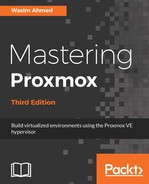Proxmox supports the .raw, .qcow2, and .vmdk virtual disk formats. Each format has its own set of strengths and weaknesses. The image format is usually chosen based on the function of the virtual machine, storage system in use, performance requirement, and available budget. The following screenshot shows the menu where we can choose an image type during virtual disk creation through the GUI:

The following table is a brief summary of the different image formats and their possible usage:
|
Image type |
Storage supported |
Strength |
Weakness |
|
.qcow2 |
NFS and directory |
Allows dynamic virtual storage of image files. |
Complex file formats with additional software layers. |
|
.raw |
LVM, RBD, iSCSI, and directory |
No additional software layer. Direct access to image files. |
Fixed virtual image only. Cannot be used to store dynamic images. |
|
.vmdk |
NFS and directory |
Works exceptionally well with the VMware infrastructure. |
Additional software layer, thus slower performance. |
